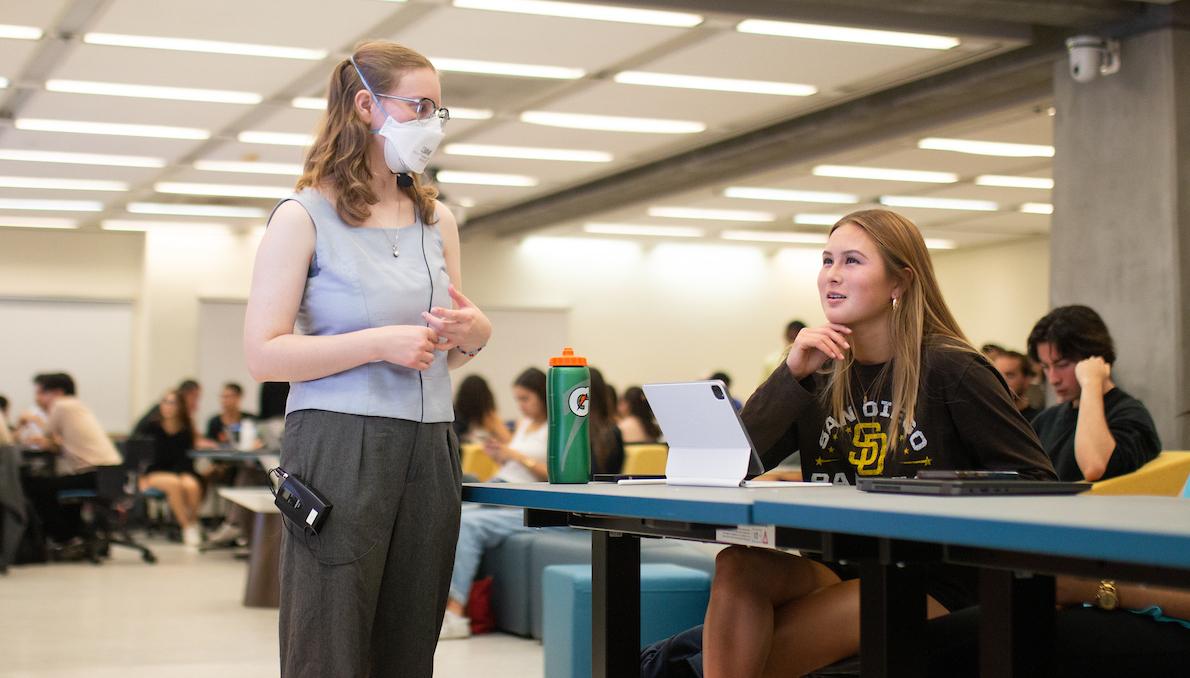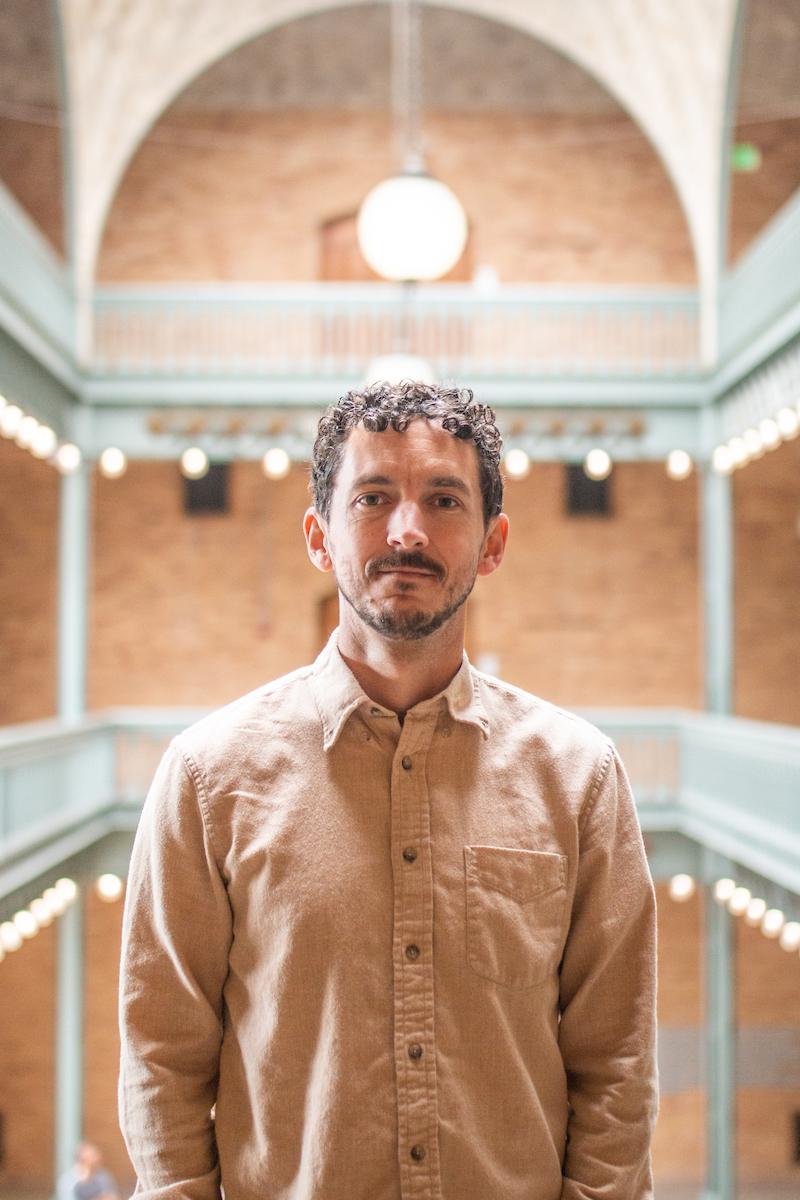In room 145 of Moffitt Library, about 100 students sit behind long rectangular desks, around round tables and on couches. It’s Wednesday, class has just started and the classmates are working in groups to solve and vote on the answer to a question projected on a screen.
“Okay, this one we’re totally divided on,” Silas Gifford, the instructor, says of the vote’s results. “Take two minutes. Find somebody that can disagree with you. Tell them why they're wrong. Convince them that they're wrong and you're right. Or, if you're wrong, be convinced of the right answer.”
Gifford and three assistants walk around the room, offering support. Minutes later, students vote again. Now, instead of the class’s relatively even split between four answers, 75 percent are behind just one. A student explains why it’s correct – and Gifford agrees. Next question.

Welcome to Stat 20, an introductory probability and statistics course and one of the few “flipped” classes at UC Berkeley. Students are introduced to new concepts through their homework and tackle practice problems during “lecture” sections. The format aims to improve comprehension, connection and attendance.
A flipped classroom approach isn’t new, with decades’ worth of research proving its effectiveness. But classes like Stat 20 put a Berkeley spin on that model. As many educators work to reimagine the post-pandemic classroom, this structure offers one pathway to tackle large lectures differently and “re-humanize” these kinds of courses.
“I wanted to think through how we could re-purpose instructor energy and time and channel it towards an environment that students would find useful,” said Andrew Bray, an associate teaching professor in the Statistics Department. “The flipped classroom does that.”
Trying a flipped classroom model
Bray started teaching Stat 20, a class that’s been taught in the Statistics Departments for decades, in spring 2022. He would hold in-person large lectures for a roughly 650-person class. He’d also record them, so students could watch them from home.
Later in the semester, he saw his lecture attendance drop to 38 percent. But some of his teaching assistants’ attendance remained between 80 and 90 percent, he said. That and other indicators spurred him to consider whether there was another model for teaching the class.
“What students seemed to find the most valuable was a really well-taught smaller discussion section where they were actually problem solving,” Bray said.

Inspired in part by a Berkeley course taught by Political Science Associate Professor David Broockman, he initiated a new approach to teaching Stat 20. He sent students lecture notes to study at home and converted most lectures into time to practice the new concepts they had read about.
He split the course that sometimes included 800 to 900 students into 100-person sections. And he re-shaped the instruction team. Before he was the only Stat 20 instructor and he had support from 15 teaching assistants and a team of readers. Today, the course has five instructors – faculty members, lecturers and a teaching assistant who each lead at least one section. It still has readers and each section has three tutors or in-class assistants.
“It's creating an alternative that suits some students better,” said Deborah Nolan, associate dean for students at Berkeley’s College of Computing, Data Science, and Society, of the class structure. “The faculty have [also] enjoyed tremendously… having a community of instructors who share curriculum [and] teaching techniques.”
Alexander Smith, who completed Stat 20 last year, is one student who benefited. This format helped him make better use of class time, he said. He learned before class what concepts were confusing, which allowed him to ask the instructor about them during the time that would traditionally be used for lectures. It also enabled him to move more quickly onto new material.
“We were able to read through introductory material beforehand, so that during class time we could spend class working through higher-level examples and spend time actually implementing what we had read about,” said Smith, now a third-year economics major with a data science minor.
Improved relationships, accessibility and attendance
The impacts are bigger than one student. A larger share of students have the opportunity to receive support from and build relationships with their teachers, Nolan said. Instructors are able to provide more individualized attention to students who need additional accessibility support, like visually impaired students, Bray said.
Perhaps most notably, Bray said he’s seen the tone among the students become more positive. During the pandemic, he and other instructors saw students bullying one another, spreading false information and rage-posting in class forums. Those issues have pretty much disappeared.
“Culturally it's hard to keep a positive, mutually trusting environment when our classes start looking more like YouTube and the comment threads on YouTube, as opposed to a room where we're all kind of working on the same thing together and have shared goals,” said Bray.
"Culturally it's hard to keep a positive, mutually trusting environment when our classes start looking more like YouTube."
More students come to the lectures later in the semester, too, rather than solely attending their discussion sections, Bray said. Under the flipped classroom approach last year, he said Stat 20 had between 50 and 90 percent attendance at lectures depending on the section’s time of day.
Bray is still considering further tweaking the class moving forward, and the flipped classroom format has given him additional tools to do that. The instructors see where the pain and interest points in the curriculum are and get new ideas of how to better tailor the class to students.
But mostly Bray is focused on improving through each and every class the relationships between the instructors and students. He wants the educators to know their students’ needs and how to effectively teach them. He wants students to know their teachers care about them.
“My main goal is to humanize the classroom. In a large lecture, students can feel like they're anonymous; just a number,” Bray said. “These smaller in-person classes allow us to get to know one another and build the mutual trust that's so helpful in teaching and learning."
